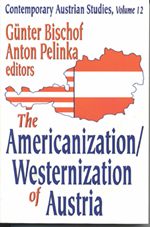Book Presentation
“What do very diverse Austrians, such as Federal Chancellor Wolfgang Schüssel and Carinthian Governor Jörg Haider, have in common? They both were influenced by their stay in the U.S.A.,” explained Professor Günter Bischof, Director of Center Austria of the University of New Orleans at the presentation of the book, The Americanization/Westernization of Austria on April 5, 2004 at the Austrian Embassy in Washington, D.C.
Although the ‘americanizing’ of Austria goes back to the 19th century, it peaked following WW II. America influenced the political and economic reconstruction of Austria via the Marshall Plan and supported the 'Great Coalition' which was regarded as a stronghold against communism. With the beginning of a new postwar era, some 7,000 young people of Austria participated in visiting programs in the U.S. in the 60s, such as the American Field Program (AFS), or received Fulbright scholarships for studies at American universities.

Their experiences and impressions following their return to Austria often had a “multiplying effect” to this day.
It is this extraordinary “soft power” and not its military power which gained the sympathy of others for America’s culture, way of living, values and principles, according to Prof. Bischof. “Seduction instead of force” - that was the real secret of americanization. It was American ideas, at once modern, attractive and energizing.
The Americanization/Westernization of Austria, Günter Bischof and Anton Pelinka (eds.); Contemporary Austrian Studies, Vol. 12; Transaction Publishers, 2004; 316 pgs.; ISBN:0-7658-0803-x.
